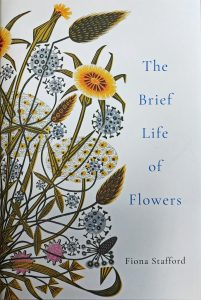Fiona Stafford, fellow and tutor in English Literature at Somerville, has published a new book, The Brief Life of Flowers, which has received favourable reviews in The Sunday Times, the Spectator and the Daily Mail. Here, she explains how flowers are intertwined with literature, art, history, politics and society.
What inspired you to write this book?
Flowers have been with me all my life. My mother Gill, to whom the book is dedicated, was a florist and my grandfather had a nursery so it is a perennial interest. After the success of The Long Long life of Trees, it felt like a natural next step.
The book is a series of short essays about flowers that almost everybody would recognize in the garden or in the wild. Because they are so well known, they have suggested themselves to writers, artists, and political parties for centuries.
What’s an example of the relationship between flowers and human history?
If you take the rose, it has got so many associations; Umberto Eco called his book The Name of the Rose, because the flower has so many meanings that it meant nothing, or so he said.
But then what I do is to look at some of the different meanings of the rose, and there are so many. In relation to politics, you have the Wars of the Roses, and the white and red rose then come together to form the Tudor rose. The eglantine rose was a symbol of Queen Elizabeth the First, but the rose was also claimed as a symbol by the Jacobites and later became a symbol of Ireland. When WB Yeats wrote poems about the rose he was thinking of Ireland. It’s associated with France as well; Napoleon’s empress Josephine had a famous rose garden at Malmaison.
So the rose is an equivalent of the oak, a powerful flower claimed by lots of different nations for different reasons.
Why do flowers lend themselves to human use?
They are very beautiful and they accompany us at all the most important moments of life. Every wedding will have flowers. When people die, there is a powerful impulse to lay flowers on graves. And they are present at births too; people give new mothers bunches of flowers. This cuts across cultures and across centuries, people instinctively turn to flowers at all the moments that matter.
And at a wedding, while you might be aware there are lovely flowers everywhere, you don’t necessarily think about all the work that has gone into these extraordinary things, so the book is dedicated to my mum, and dedicated to all the people who enhance the world without necessarily being recognized, the growers who cultivate flowers, the gardeners who tend them, the farmers who allow wildflowers to flourish, the people who plant bulbs along the roadside, the florists who arrange them.
Tell us a surprising fact about flowers!
There are so many surprising facts about flowers. If you think about the traditional medical use of flowers, foxglove was a wonder-drug in the late eighteenth century, and research carried out by medical botanists at the time provided the first effective treatment of congestive heart failure. When John Keats was a medical student at Guy’s he was listening to lectures on digitalis and writing poems about foxgloves.
The Brief Life of Flowers is published by John Murray.
